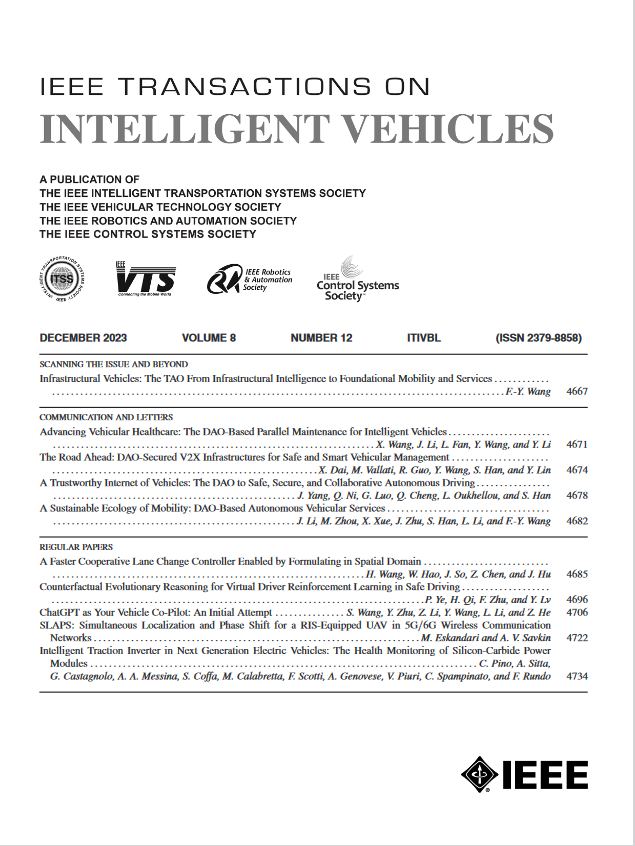Progressive Contextual Trajectory Prediction With Adaptive Gating and Fuzzy Logic Integration
IF 14
1区 工程技术
Q1 COMPUTER SCIENCE, ARTIFICIAL INTELLIGENCE
引用次数: 0
Abstract
Despite the rapid advancement of highly automated vehicles poised to mitigate accidents caused by human errors, understanding the behaviors of road users, especially vulnerable pedestrians, remains a significant challenge. The evolution of pedestrian trajectory prediction, transitioning from early motion models to recent deep learning approaches, has highlighted persistent challenges in accurately predicting future trajectories, particularly in complex scenarios. To address this, this paper presents a Progressive Contextual Trajectory Prediction with Adaptive Gating and Fuzzy Logic Integration (PCTP-AGFL). The proposed method incorporates a dynamic progressive generator (DPG) comprising multiple LSTM layers that adapt progressively to pedestrian motion pattern complexities. The DPG is trained using a learned scheduled sampling strategy implemented through an Adaptive Gating Mechanism (AGM), allowing dynamic switching between teacher forcing and normal mode. This is augmented with an Encoder-Decoder Contextual Attention (EDCA) module to enhance contextual awareness. Additionally, a novel Adaptive Fuzzified Discriminator (AFD) is introduced to enhance the model's capability to handle ambiguous trajectories. Experimental results on JAAD/PIE and ETH/UCY datasets demonstrate the method's superiority over baselines and state-of-the-art approaches. Furthermore, a comprehensive ablation study is carried out to tune the progression parameters, training strategy, and the type of classifier logic in the discriminator.基于自适应门控和模糊逻辑集成的渐进式上下文轨迹预测
尽管高度自动化的车辆在快速发展,以减轻人为错误造成的事故,但了解道路使用者的行为,特别是脆弱的行人,仍然是一个重大挑战。行人轨迹预测的发展,从早期运动模型过渡到最近的深度学习方法,突出了准确预测未来轨迹的持续挑战,特别是在复杂的场景中。为了解决这个问题,本文提出了一种基于自适应门控和模糊逻辑集成的渐进式上下文轨迹预测(PCTP-AGFL)。该方法采用了一个动态渐进生成器(DPG),该生成器由多个LSTM层组成,逐步适应行人运动模式的复杂性。DPG使用通过自适应门控机制(AGM)实现的学习调度采样策略进行训练,允许在教师强迫和正常模式之间动态切换。这是一个编码器-解码器上下文注意(EDCA)模块增强上下文意识。此外,引入了一种新的自适应模糊鉴别器(AFD)来增强模型处理模糊轨迹的能力。在JAAD/PIE和ETH/UCY数据集上的实验结果表明,该方法优于基线和最先进的方法。此外,还进行了全面的消融研究,以调整鉴别器中的进度参数、训练策略和分类器逻辑类型。
本文章由计算机程序翻译,如有差异,请以英文原文为准。
求助全文
约1分钟内获得全文
求助全文
来源期刊

IEEE Transactions on Intelligent Vehicles
Mathematics-Control and Optimization
CiteScore
12.10
自引率
13.40%
发文量
177
期刊介绍:
The IEEE Transactions on Intelligent Vehicles (T-IV) is a premier platform for publishing peer-reviewed articles that present innovative research concepts, application results, significant theoretical findings, and application case studies in the field of intelligent vehicles. With a particular emphasis on automated vehicles within roadway environments, T-IV aims to raise awareness of pressing research and application challenges.
Our focus is on providing critical information to the intelligent vehicle community, serving as a dissemination vehicle for IEEE ITS Society members and others interested in learning about the state-of-the-art developments and progress in research and applications related to intelligent vehicles. Join us in advancing knowledge and innovation in this dynamic field.
 求助内容:
求助内容: 应助结果提醒方式:
应助结果提醒方式:


